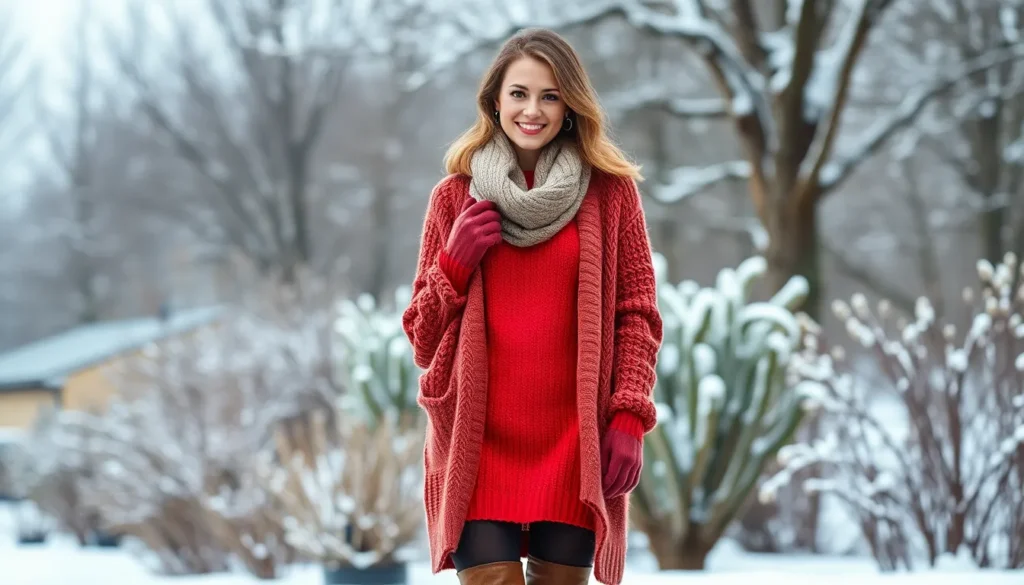Winter doesn’t mean we have to abandon our favorite dresses and resign ourselves to bulky sweaters and heavy pants. We’ve all faced that frustrating moment when the temperature drops but we still want to look feminine and stylish. The good news? We can absolutely rock dresses during the coldest months with the right layering techniques and strategic styling choices.
Smart layering is the secret to making any dress winter-ready. From choosing the right undergarments to mastering the art of outerwear coordination we’ll show you how to stay warm without sacrificing style. Whether you’re heading to the office or planning a night out we believe every woman deserves to feel confident and comfortable in what she wears.
The key lies in understanding which fabrics work best for winter weather and how to create stylish combinations that actually keep you cozy. Let’s explore the proven strategies that’ll transform your dress game this season.
Layer With Thermal Undergarments for Warmth
Building a solid foundation underneath your winter dress starts with choosing the right thermal undergarments. We’ll show you how to select base layers that keep you warm without adding bulk to your silhouette.
Choose Moisture-Wicking Base Layers
Synthetic fabrics like polyester and nylon blends work exceptionally well for thermal base layers because they pull sweat away from your skin. These materials prevent that clammy feeling you’d get with cotton undergarments when temperatures fluctuate between indoor heating and outdoor cold.
Merino wool base layers offer natural temperature regulation and odor resistance for all-day comfort. This premium option costs more than synthetic alternatives but provides superior breathability and softness against your skin.
Bamboo fiber undergarments combine moisture-wicking properties with natural antibacterial benefits. We recommend these eco-friendly options for women with sensitive skin who need gentle yet effective thermal protection.
Avoid cotton base layers entirely when wearing dresses in winter weather. Cotton retains moisture and loses its insulating properties when wet, leaving you cold and uncomfortable throughout the day.
Opt for Seamless Thermal Tops and Bottoms
Seamless construction eliminates visible lines under form-fitting dresses and prevents chafing during extended wear. Look for thermal sets with flat-seam technology or completely seamless designs that won’t create unwanted texture under your outfit.
Long-sleeve thermal tops should extend past your wrist bones to prevent gaps when layering with outerwear. Choose styles with thumbhole details to keep sleeves in place when putting on sweaters or coats over your dress.
Full-length thermal leggings provide complete leg coverage without bunching at the ankles. Select options with stirrup feet or compression ankle cuffs to maintain smooth lines under boots and prevent riding up during movement.
Camisole and brief sets work better than full-body options when wearing shorter dresses or wanting more styling flexibility. These separates allow you to adjust coverage based on your exact dress length and neckline.
Add Cozy Cardigans and Sweaters Over Your Dress

Layering becomes effortless when you choose the right cardigan or sweater to complement your winter dress ensemble. These versatile pieces transform lightweight dresses into weather-appropriate outfits while maintaining your feminine silhouette.
Select Chunky Knit Cardigans for Texture
Chunky knit cardigans provide exceptional warmth while adding visual interest to your winter dress looks. These substantial pieces create cozy layers that work perfectly over lightweight dresses, transforming summer favorites into cold-weather staples. Textured knits like cable patterns, ribbed designs, and oversized stitches bring dimension to your outfit without overwhelming your dress’s original style.
We recommend choosing cardigans in neutral tones such as cream, camel, or charcoal gray for maximum versatility across your dress collection. Longer cardigan lengths offer additional coverage and warmth, while cropped styles work beautifully with high-waisted or midi dresses. Button-front cardigans give you flexibility to adjust your coverage throughout the day, and open-front styles create flowing lines that complement fitted dresses.
Natural fibers like wool and alpaca blends deliver superior insulation compared to synthetic alternatives. These materials regulate temperature effectively while providing the substantial texture that makes chunky knits so appealing for winter styling.
Try Fitted Turtlenecks for Sleek Layering
Fitted turtlenecks worn under dresses create polished winter looks without adding unwanted bulk to your silhouette. This layering technique works exceptionally well with sleeveless or thin-strapped dresses, providing essential warmth while maintaining a streamlined appearance. Turtlenecks in lightweight materials like merino wool or cotton blends layer smoothly under most dress styles without creating uncomfortable bunching.
Colors play a crucial role in achieving sophisticated turtleneck layering combinations. Black turtlenecks create classic contrast under patterned or brightly colored dresses, while matching your turtleneck to your dress creates a cohesive monochromatic look. White or cream options brighten darker winter dresses and add fresh contrast to your cold-weather wardrobe.
Sleeve length considerations help you achieve the most flattering layered appearance. Long-sleeved turtlenecks work perfectly under sleeveless shift dresses or jumpers, while three-quarter sleeves complement dresses with shorter sleeves. Mock turtlenecks offer the neck coverage and warmth benefits without the full collar height, making them ideal for dresses with detailed necklines you don’t want to hide.
Pair With Warm Tights and Leggings

Adding the right hosiery beneath your dress transforms cold weather styling from challenging to effortless. We’ve found that strategic layering with quality tights and leggings creates the perfect foundation for winter dress outfits.
Choose Fleece-Lined Tights for Extra Insulation
Fleece-lined tights deliver exceptional warmth while maintaining a lightweight feel against your skin. These winter wardrobe essentials provide important insulation when normal hosiery simply won’t cut it on frigid days. We recommend investing in quality fleece-lined options that work seamlessly under any dress length while looking polished with boots or winter shoes.
Comfort becomes paramount when temperatures drop, and fleece-lined tights excel at keeping your legs cozy without sacrificing your personal style. Their lightweight construction means you won’t feel weighed down, yet they offer the thermal protection needed for extended outdoor exposure. Quality fleece-lined tights also resist runs and tears better than traditional options, making them a practical long-term investment for your winter wardrobe.
Layer Leggings Under Shorter Dresses
Fitted leggings create an excellent foundation when your favorite shorter dresses need extra coverage for chilly weather. We suggest choosing black leggings as they blend seamlessly with most dress styles and colors, creating a cohesive look that appears intentional rather than improvised. This practical layering technique extends your dress-wearing days well into the colder months.
Skinny pants work equally well for this layering approach, particularly when you want a more structured appearance. The key lies in selecting fitted options that won’t create bulk or visible lines beneath your dress. We find that high-quality stretch fabrics move naturally with your body while providing the warmth and coverage needed for winter comfort.
Incorporate Statement Outerwear
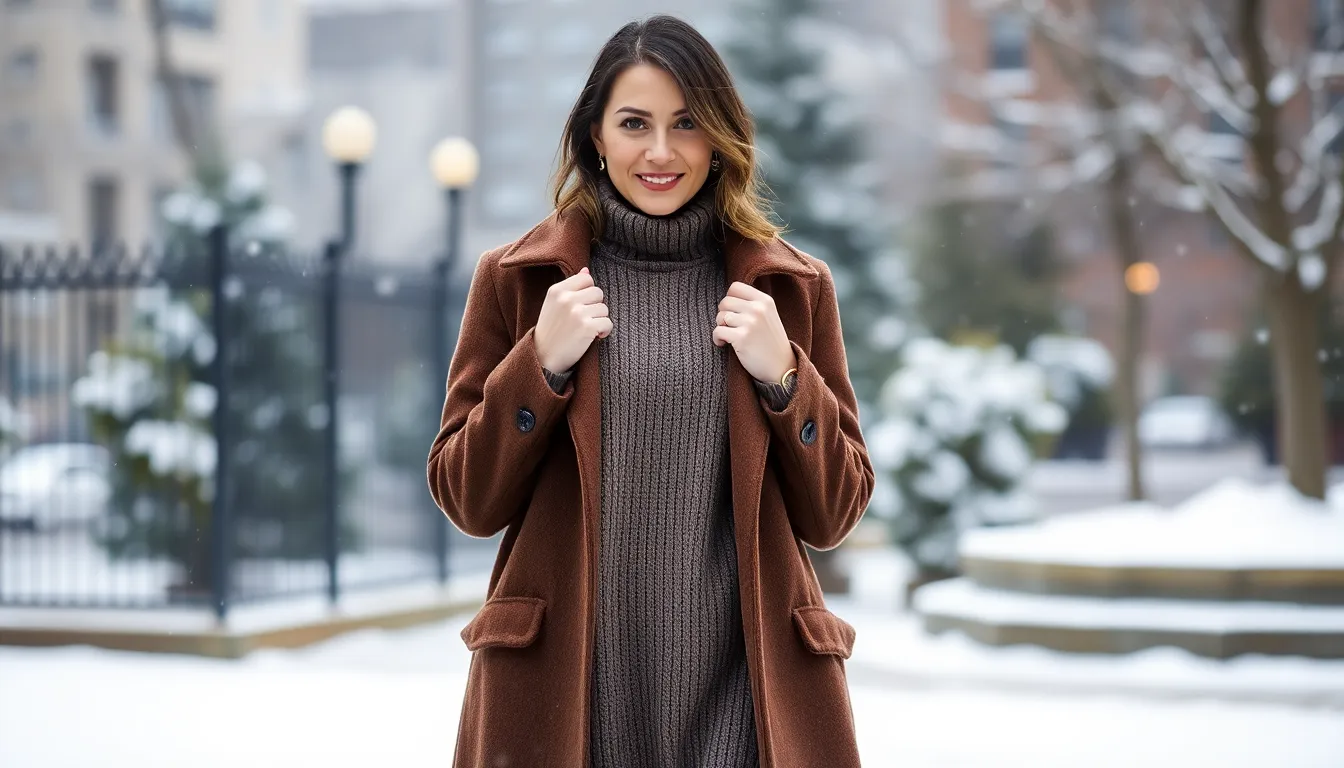
Statement outerwear transforms winter dress styling by adding both warmth and visual impact to your ensemble. We recommend selecting structured pieces that complement your dress silhouette while providing essential cold weather protection.
Invest in a Wool Coat or Peacoat
Longline wool coats create elegant proportions when paired with maxi sweater dresses and ballet flats. We love how these extended silhouettes add sophistication to casual winter looks while maintaining warmth throughout the day.
Peacoats deliver classic styling that works beautifully with various dress lengths and styles. This timeless outerwear choice adds structured appeal to your winter wardrobe and transitions seamlessly from day to evening events.
Wool blend options provide superior insulation compared to synthetic alternatives. We suggest choosing coats with at least 70% wool content for optimal warmth retention and durability throughout multiple winter seasons.
Neutral colors like camel, navy, and charcoal maximize versatility across your dress collection. These shades complement both bold and subtle dress patterns while creating a cohesive winter aesthetic.
Try a Puffer Jacket for Casual Winter Looks
Puffer jackets offer exceptional warmth for casual winter dress styling without sacrificing comfort or mobility. We find these insulated pieces perfect for weekend activities and relaxed outings where practicality meets style.
Cropped puffer styles work particularly well with longer dresses and midi lengths. This proportional balance creates visual interest while ensuring your dress remains the focal point of your outfit.
Fitted puffer designs avoid overwhelming smaller dress silhouettes and maintain a streamlined appearance. We recommend these customized options for petite frames or when wearing form fitting dresses.
Down alternative fillings provide cruelty free warmth while maintaining the same insulation properties as traditional down. These synthetic options also perform better in wet conditions and require less specialized care.
Choose the Right Winter Footwear
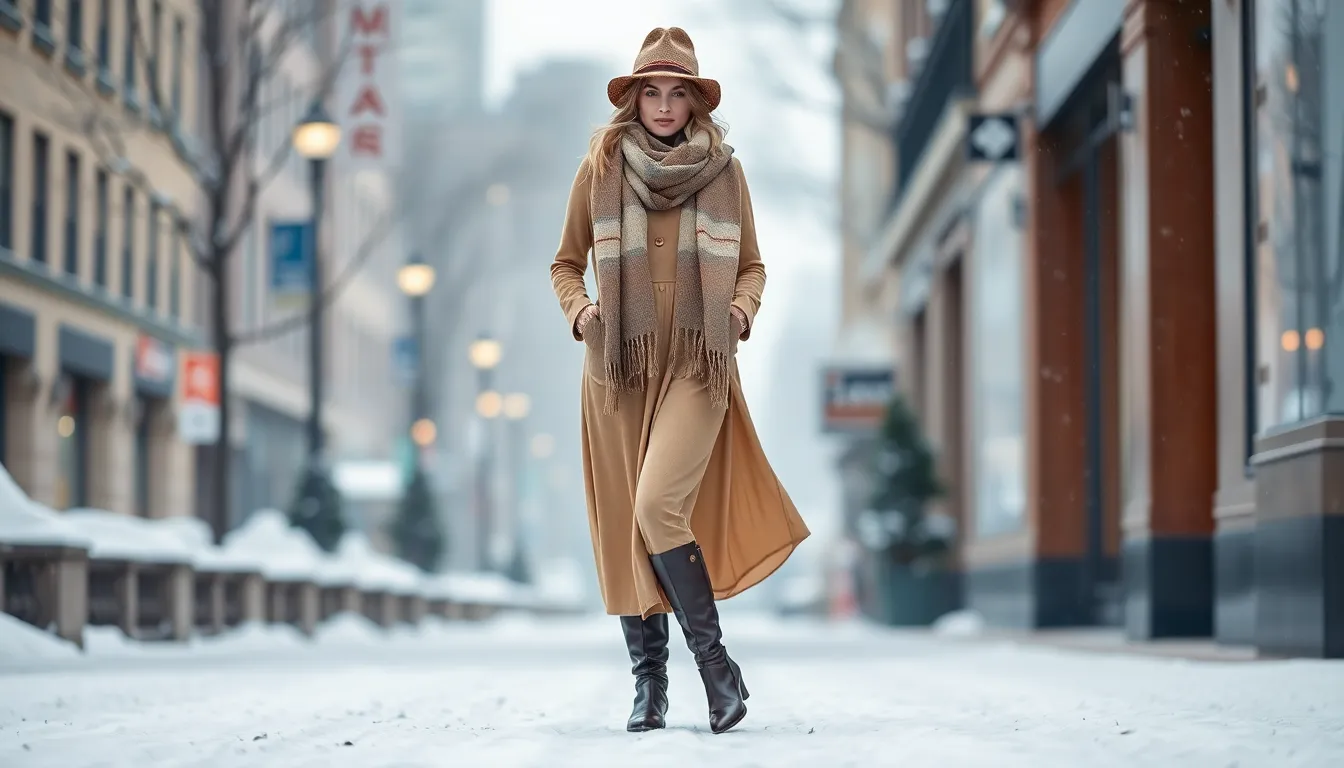
Winter footwear plays a crucial role in keeping our feet warm while maintaining the elegant silhouette of our dress outfits. The right boots can transform our winter dress styling from basic to sophisticated.
Wear Knee-High Boots for Coverage
Knee-high boots provide excellent coverage and warmth, pairing beautifully with longer dresses for a polished winter look. These boots create a seamless transition between our dress hemline and footwear, eliminating any exposed skin that might feel cold.
Leather knee-high boots offer durability and water resistance, making them ideal for snowy or wet winter conditions. Suede options add texture and visual interest to our outfits, though they require more careful maintenance during harsh weather.
We’ll find that knee-high boots work particularly well with midi and maxi length dresses, creating balanced proportions. Heeled versions elongate our legs and add sophistication to professional winter outfits, while flat styles provide comfort for all-day wear.
Black and brown remain the most versatile color choices, complementing virtually any dress pattern or color scheme. Statement knee-high boots in burgundy or navy can add personality to neutral colored dresses without overwhelming our overall look.
Opt for Ankle Boots With Thick Socks
Ankle boots paired with thick socks create an effective warming system while adding style to shorter dress lengths. This combination allows us to wear our favorite mini and knee-length dresses throughout the colder months.
Thick wool or cashmere blend socks provide insulation between our feet and the boots, creating an extra barrier against cold temperatures. We can choose socks that peek slightly above the boot line for a deliberately layered aesthetic, or select low-profile options for a cleaner appearance.
Combat style ankle boots offer a trendy edge to feminine dress silhouettes, while Chelsea boots provide a more refined and streamlined look. Heeled ankle booties elevate our winter dress outfits for evening occasions or professional settings.
The key lies in selecting ankle boots with enough room to accommodate thicker socks without creating uncomfortable pressure points. We should ensure the boot material allows for slight stretch or choose a half size larger than our usual fit when planning to wear substantial sock layers.
Accessorize With Scarves and Wraps
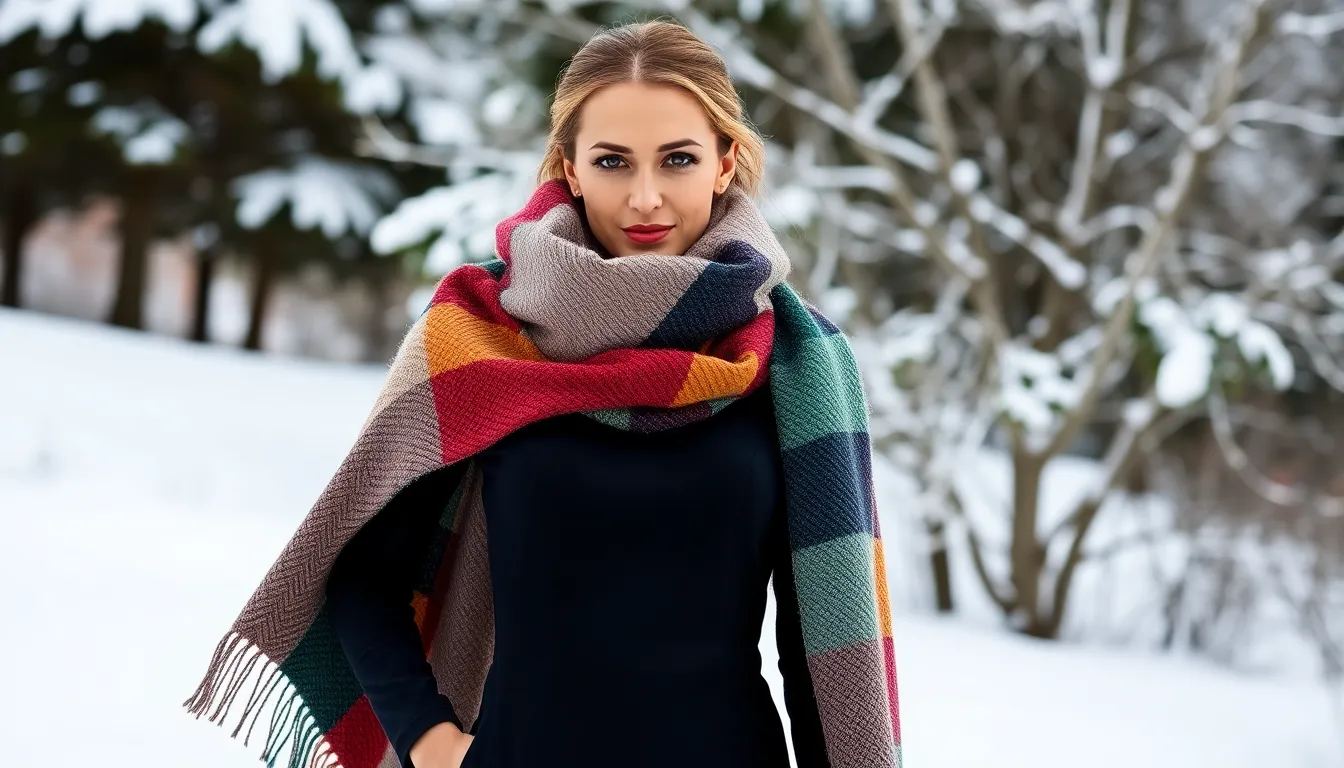
Strategic scarf and wrap selection transforms winter dress styling while providing essential warmth for exposed areas. These versatile accessories bridge the gap between style and function when temperatures drop.
Add Blanket Scarves for Extra Warmth
Blanket scarves deliver exceptional warmth through their oversized design and heavy fabric construction. We recommend choosing scarves that measure at least 60 inches in length for optimal wrapping coverage around your neck and shoulders. Wool blend blanket scarves provide superior insulation while maintaining breathability throughout the day.
Draping techniques maximize both warmth and visual appeal when styling these statement accessories. Loop the scarf once around your neck and let the ends cascade over your shoulders for effortless elegance. Alternatively, wrap the entire scarf around your shoulders like a shawl to create additional coverage over sleeveless or short sleeved dresses.
Color coordination enhances your overall winter dress ensemble while maintaining cohesive styling. Neutral tones like cream, camel, or charcoal complement multiple dress patterns and colors in your wardrobe. Bold plaid or textured patterns add visual interest to solid colored dresses without overwhelming your silhouette.
Use Pashminas to Cover Exposed Areas
Pashminas offer targeted coverage for exact areas that need extra warmth protection. We suggest selecting pashminas made from cashmere or wool blends for their lightweight feel and superior heat retention properties. These wraps excel at covering exposed chest areas, upper backs, and bare arms without adding bulk to your frame.
Styling versatility makes pashminas essential accessories for winter dress wardrobes. Drape them over one shoulder for asymmetrical elegance, or wrap them around both shoulders for complete upper body coverage. The flowing fabric creates graceful movement while providing practical warmth for open necked or sleeveless dress styles.
Strategic placement addresses common winter dress challenges while maintaining sophisticated appearances. Position pashminas to cover low necklines during outdoor activities, then adjust the draping for indoor comfort. This adaptability ensures you stay appropriately covered in varying temperatures throughout your day.
Select Winter-Appropriate Dress Fabrics

Choosing the right fabric forms the foundation of successful winter dress styling. We’ll explore which materials provide optimal warmth while maintaining the elegant silhouette you desire.
Choose Wool and Cashmere Blends
Wool blends deliver exceptional warmth and insulation for winter dress wear. These natural fibers trap body heat effectively while allowing your skin to breathe throughout the day. We recommend seeking dresses with wool content of at least 50% to ensure adequate thermal protection during colder months.
Cashmere blends offer luxurious softness combined with superior temperature regulation. The fine fibers create a lightweight yet warm layer that won’t add bulk to your silhouette. We find that cashmere wool combinations provide the perfect balance of comfort and elegance for winter occasions.
Merino wool stands out as an excellent choice for winter dresses due to its moisture wicking properties. This premium fiber naturally regulates body temperature and resists odors, making it ideal for extended wear. We suggest looking for dresses that feature merino wool blends for maximum comfort and versatility.
Wool and cashmere fabrics maintain their shape better than synthetic alternatives throughout the winter season. These materials resist wrinkles and hold their structure even with frequent layering underneath. We’ve found that investing in quality wool blend dresses pays off with longevity and consistent appearance.
Avoid Lightweight Materials Like Chiffon
Chiffon fabrics provide inadequate insulation for winter weather conditions. These sheer, lightweight materials allow cold air to penetrate easily, leaving you uncomfortable regardless of layering efforts. We recommend reserving chiffon dresses for spring and summer occasions when temperatures are more suitable.
Silk without proper lining offers minimal thermal protection during colder months. While beautiful and elegant, pure silk dresses lack the density needed to retain body heat effectively. We suggest choosing silk dresses only when they feature warm linings or when worn in heated indoor environments.
Cotton voile and lawn fabrics are too thin for winter dress styling. These breathable materials work against your comfort goals by allowing heat to escape rapidly. We advise avoiding dresses made from these lightweight cottons during winter months.
Polyester chiffon and georgette create similar thermal challenges as their natural counterparts. Even though being synthetic, these fabrics maintain the same lightweight, airy structure that makes them unsuitable for cold weather wear. We recommend selecting dresses with heavier polyester blends that offer better insulation properties.
Style Long-Sleeved Dresses for Cold Weather
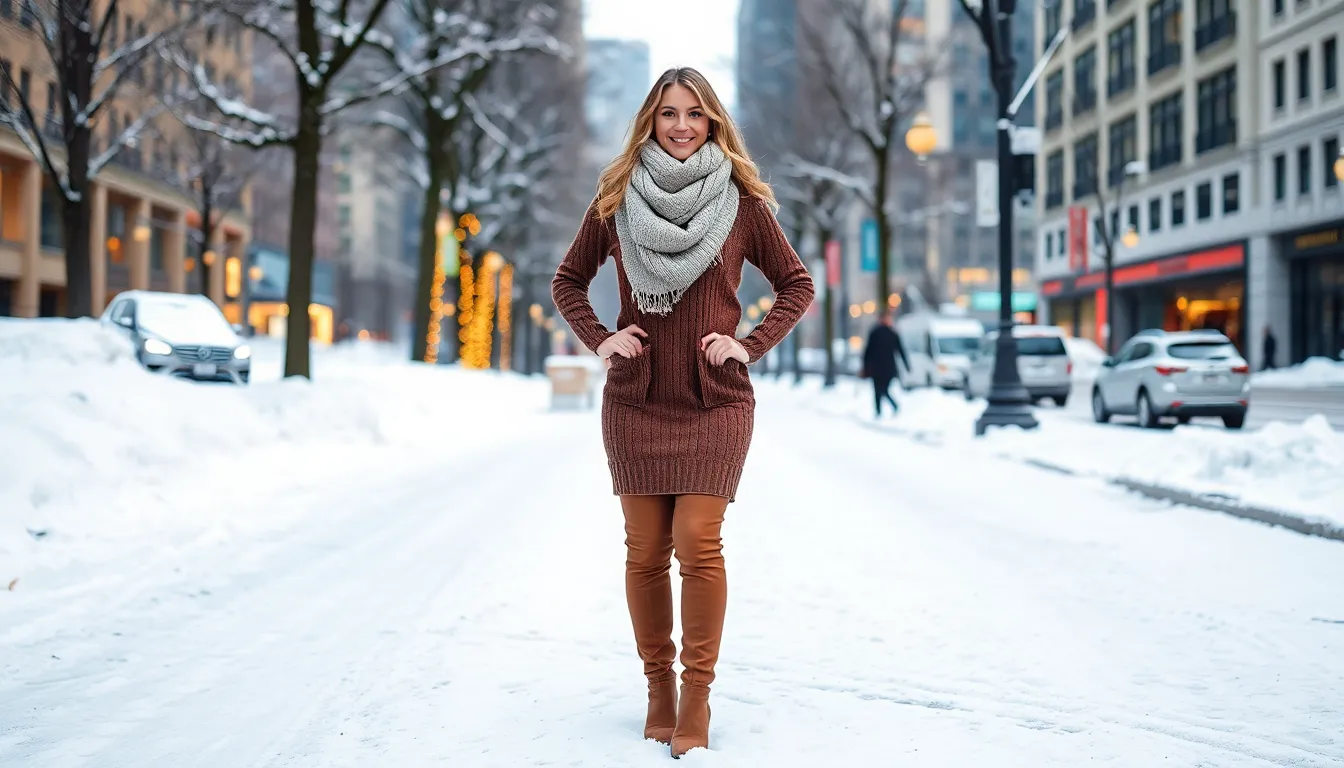
Long-sleeved dresses provide an excellent foundation for winter styling, offering built-in arm coverage while maintaining feminine elegance. We can enhance these pieces with strategic layering and fabric choices that deliver both warmth and sophistication.
Pick Sweater Dresses for Built-In Warmth
Sweater dresses deliver exceptional insulation through their knit construction, making them perfect winter staples. Knit sweater dresses made from wool or alpaca blends provide inherent warmth that eliminates the need for multiple layers underneath. We recommend selecting styles with at least 60% natural fiber content for optimal thermal regulation.
Chunky knit textures add visual interest while trapping warm air close to the body, creating natural insulation. Cable knit patterns and ribbed designs offer both warmth and style, working beautifully for casual winter outings. Fitted sweater dresses in merino wool maintain their shape while providing moisture-wicking properties that keep us comfortable throughout the day.
Turtleneck sweater dresses offer additional neck coverage, reducing the need for scarves in milder winter weather. We can pair these versatile pieces with knee-high boots and minimal accessories for effortless winter elegance.
Choose Midi and Maxi Lengths for Coverage
Midi dresses provide essential leg coverage while maintaining sophisticated proportions for winter styling. Midi lengths that fall between the knee and ankle offer optimal coverage for cold weather without overwhelming petite frames. We find that A-line midi silhouettes work particularly well with winter boots and thick tights.
Maxi dresses deliver maximum coverage and warmth, making them ideal for harsh winter conditions. Floor-length styles in wool or heavy jersey fabrics create elegant winter looks that require minimal additional layering. Wrap-style maxi dresses allow for easy layering adjustments throughout the day as temperatures fluctuate.
Long-sleeved midi and maxi options in darker colors like navy, burgundy, and charcoal gray provide versatile foundations for winter wardrobes. We can style these lengths with tall boots that complement the dress hemline, creating seamless transitions between garment and footwear. Belted maxi dresses help define the waist while allowing room for thermal layers underneath, ensuring both warmth and flattering silhouettes.
Create Stylish Winter Color Combinations

Winter dresses offer endless opportunities to experiment with rich seasonal colors that complement the colder months. We’ll explore how strategic color choices can elevate your winter dress styling while maintaining that coveted sophistication.
Embrace Rich Jewel Tones and Deep Hues
Jewel tones like emerald green, sapphire blue, ruby red, and amethyst purple create stunning winter dress foundations. These rich colors naturally complement the season’s deeper aesthetic while adding visual warmth to cold weather outfits. We recommend selecting dresses in these luxurious hues to instantly elevate your winter wardrobe.
Burgundy, navy, forest green, and plum represent classic winter color palette staples. These sophisticated shades work beautifully as standalone dress colors or as accent pieces in your layering combinations. Pairing a forest green dress with gold jewelry creates an elegant contrast that feels both seasonal and timeless.
Accessorizing jewel toned dresses with metallic jewelry enhances their natural richness. Gold accessories complement warmer jewel tones like ruby red and emerald green, while silver pairs beautifully with cooler shades like sapphire blue and amethyst purple. We suggest choosing one metallic tone per outfit to maintain visual cohesion.
Balancing bold jewel tones with neutral outerwear prevents overwhelming your winter ensemble. A navy peacoat over a ruby red sweater dress creates sophisticated contrast without competing colors. Neutral boots in camel or black provide grounding elements that let your dress color take center stage.
Mix Neutrals for Sophisticated Winter Looks
Combining neutrals such as ivory, camel, black, and gray creates versatile winter dress foundations. These timeless colors offer endless mixing possibilities while maintaining understated elegance throughout the season. We find that neutral combinations work particularly well for professional winter dressing and transitional weather days.
Layering neutral coats or sweaters over dresses provides both warmth and visual sophistication. A camel wool coat over a black sweater dress creates classic contrast, while an ivory cardigan over a gray dress offers subtle tonal variation. Adding fleece lined tights in coordinating neutral shades completes the polished look.
Incorporating neutral accessories ties winter dress outfits together seamlessly. Scarves in cream or beige add texture without introducing competing colors, while neutral handbags and shoes create cohesive styling. We recommend selecting accessories in the same color family to maintain visual flow throughout your outfit.
Texture variation within neutral palettes prevents monotonous winter dress styling. Mixing smooth wool with chunky knits or matte fabrics with subtle shine adds visual interest while maintaining color harmony. A smooth black dress paired with a textured gray cardigan and suede boots demonstrates how different textures elevate simple neutral combinations.
Conclusion
Winter doesn’t have to mean hiding our favorite dresses in the closet. With the right combination of thermal layers smart outerwear choices and strategic styling we can confidently wear dresses throughout the coldest months while staying warm and fashionable.
The key lies in building a foundation with quality thermal undergarments choosing appropriate fabrics like wool blends and incorporating versatile accessories that enhance both warmth and style. From fleece-lined tights to statement coats every element works together to create cohesive winter looks.
We’ve shown that winter dress styling is all about balance—combining practicality with elegance through thoughtful layering techniques. By following these approaches we can maintain our personal style year-round regardless of temperature.
Frequently Asked Questions
Can I wear dresses in winter without feeling cold?
Yes, you can wear dresses in winter by utilizing smart layering techniques. Start with thermal undergarments made from moisture-wicking synthetic fabrics or merino wool. Add warm tights or leggings, layer with cardigans or turtlenecks, and finish with statement outerwear like wool coats. Choose winter-appropriate dress fabrics with at least 50% wool content for optimal warmth while maintaining style.
What are the best thermal undergarments for wearing under dresses?
The best thermal undergarments are made from moisture-wicking synthetic fabrics like polyester and nylon blends, or natural merino wool for temperature regulation and odor resistance. Bamboo fiber options work well for sensitive skin. Choose seamless thermal tops and bottoms to avoid visible lines. Avoid cotton base layers as they retain moisture and cause discomfort.
How do I layer cardigans and sweaters with dresses for winter?
Choose chunky knit cardigans in neutral tones for versatility and warmth. Longer cardigans provide extra coverage, while cropped styles pair well with high-waisted dresses. Opt for natural fibers like wool and alpaca blends for superior insulation. Fitted turtlenecks work excellently under sleeveless dresses, creating sleek, polished looks with proper color coordination.
What type of tights and leggings work best with winter dresses?
Fleece-lined tights offer exceptional warmth and comfort while remaining lightweight and durable. They’re perfect for maintaining style without bulk. For shorter dresses, layer fitted leggings underneath for added coverage – black leggings create the most cohesive look. Choose high-quality stretch fabrics that provide warmth and structure without adding unnecessary bulk to your silhouette.
What outerwear should I choose to style winter dresses?
Invest in structured pieces like longline wool coats or peacoats with at least 70% wool content for optimal warmth. Choose neutral colors like camel, navy, and charcoal to complement various dress patterns. For casual looks, puffer jackets offer exceptional warmth – cropped styles balance longer dresses while fitted designs maintain a streamlined appearance.
What footwear works best with winter dresses?
Knee-high boots provide excellent coverage and seamlessly transition with longer dresses. Choose leather options for durability and water resistance. For shorter dresses, ankle boots paired with thick socks offer insulation and style. Ensure comfortable fit when wearing thicker socks, and select boot styles that enhance your overall winter dress outfit aesthetic.
How can accessories enhance my winter dress styling?
Blanket scarves with oversized designs and heavy fabrics provide essential warmth – choose styles measuring at least 60 inches for optimal coverage. Use proper draping techniques to maximize warmth and visual appeal. Pashminas offer versatile, targeted coverage for exposed areas like chest and arms. Coordinate colors to maintain cohesive styling throughout your winter outfit ensemble.
What dress fabrics are best for winter wear?
Choose dresses with wool and cashmere blends containing at least 50% wool content for adequate thermal protection. Cashmere blends offer luxurious softness and temperature regulation, while merino wool provides excellent moisture-wicking properties. Avoid lightweight materials like chiffon, unlined silk, and thin cottons, as they don’t provide sufficient insulation for cold weather.
Are long-sleeved dresses good for winter styling?
Long-sleeved dresses are excellent for winter as they provide built-in arm coverage and elegance. Choose sweater dresses made from wool or alpaca blends with at least 60% natural fiber content. Chunky knit textures and fitted merino wool styles offer superior warmth and moisture-wicking properties while maintaining a sophisticated, stylish appearance.
What colors work best for winter dress styling?
Rich jewel tones like emerald green, sapphire blue, and ruby red elevate winter dress styling beautifully. Pair these vibrant colors with neutral outerwear to maintain balance and sophistication. Neutral color combinations offer versatility – use layering techniques and accessories to enhance visual cohesion. Add texture variation within neutral palettes to create interesting, stylish winter outfits.

